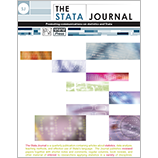Estimating and modeling relative survival
Abstract. When estimating patient survival using data collected by population-based
cancer registries, it is common to estimate net survival in a relative-survival
framework. Net survival can be estimated using the relative-survival ratio,
which is the ratio of the observed survival of the patients (where all deaths
are considered events) to the expected survival of a comparable group from the
general population. In this article, we describe a command, strs, for
life-table estimation of relative survival. We discuss three methods for
estimating expected survival, as well as the cohort, period, and hybrid
approaches for estimating relative survival. We also implement a life-table
version of the Pohar Perme (2012, Biometrics 68: 113–120)
estimator of net survival, and we describe two methods for age standardization.
We also explain how, in addition to net probabilities of death, crude
probabilities of death due to cancer and due to other causes can be estimated
using the method of Cronin and Feuer (2000, Statistics in Medicine 19:
1729–1740). We conclude this article with discussion and examples of
modeling excess mortality using various approaches, including the
full-likelihood approach (using the ml command) and Poisson regression
(using the glm command with a user-specified link function).
View all articles by these authors:
Paul W. Dickman, Enzo Coviello
View all articles with these keywords:
strs, excess mortality, relative survival, survival analysis, Poisson regression, life table, cancer survival, period analysis
Download citation: BibTeX RIS
Download citation and abstract: BibTeX RIS
|
